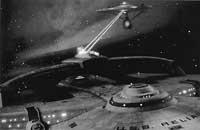Atomic lasers
It can be said that 1997 will be atomic laser. Until now, classical lasers emit light, but atomic lasers would emit rays of matter thinner than hair. The possession of this type of lasers still seems a science fiction, but in 1997 the first step has been taken.
Wolfgang Ketterle and his team at the Massachusetts Institute of Technology (MIT) in the United States have prepared a revolutionary laser in the laboratory. Instead of emitting the ray of light it projects a fine ray of atoms. Manipulating matter at the atom level, concentrating it to a very precise beam and reaching very long distances is the dream of many scientists.

This technological advance is another stage of the long scientific journey. Its origin dates back to 1924, when Albert Einstein and Satyendranath Bose made known a strange state of matter. In this situation atoms lost their individual character and formed a whole. Atoms behaved as if they formed a giant quantum particle. However, to obtain this result, known as Bose-Einstein condensation, it is first necessary to cool the atoms to practically zero absolutes (-273,15 (C).
It has long been very difficult to reach these temperatures, but in 1995 two groups of American researchers brought the atoms closer to the more than one million degrees of the last cold border. The Ketterle team passed the test last November, when it got its first laser pulsation.
The procedure needs to be fine-tuned. In fact, the ray of atoms is not continuous, it works at successive gusts and the direction is not controlled. However, the US military investigates possible applications of the atomic laser.
The atomic laser can make the desired dreams, but it also has its limitations. At the moment it can only work in vacuum because in the atmosphere the ray of atoms would be removed immediately.






